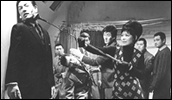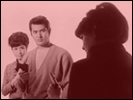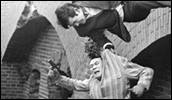Black Tight Killers
- Year
- 1966
- Original title
- Ore ni Sawaru to Abunaize
- Japanese title
- 俺にさわると危ないぜ
- Director
- Cast
- Running time
- 84 minutes
- Published
- 10 May 2001



by Jasper Sharp
Prior to devoting their entire production to the Roman Porno line of slickly made skinflicks in the early 70s, Nikkatsu's output throughout the previous decade had been heavily oriented towards a youth audience, predominantly falling within two genres: the akushon eiga (action film) and the seishun eiga (youth film). The latter were influenced by American films such as Nicholas Ray's Rebel Without A Cause and Richard Brooks' The Blackboard Jungle (both 1955) and reflected the growing autonomy that teenagers were experiencing the world over through means of rock 'n' roll music and fashion.
Nurtured by the studio as a teen idol, the immaculately groomed Akira Kobayashi played the handsome lead in a number of these films throughout the sixties such as Seijun Suzuki's early contributions to the seishun genre, Young Breasts (Aoi Chibusa, 1958) and The Spring that Didn't Come (Fumihazushita Haru, 1958), and action fare such as the Wandering Guitarist series (Gita wo Motta Wataridori, 1959 - Buichi Saitoh) and The Night Mist (Yogiri no Bojo, 1966 - Akinori Matsuo).
In this film Kobayashi takes the lead as combat photographer Daisuke Hondo who, when his glamorous air stewardess girlfriend Yoriko (Matsubara) is kidnapped, follows a trail which leads to the Momochi Research Institute, training ground to a bunch of catsuited female assassins - the Black Tight Killers of the title. Not long after a man claiming to be Yoriko's uncle enters into the fray with tales of hidden gold stashed away during the War, and before long Daisuke's American buddy Lopez soon turns out to be not quite what he seems. It's a race to the finish to find the hidden booty in which Hondo's life permanently hangs in the balance. However, whenever things look like they might get a little too rough for our clean cut young hero, there always seems to be one of these slinky ninja maidens on hand to bail him out, replete with their deadly arsenal of bubble gum to blind opponents and razor edged pop records doubling as shuriken.
If I had to explain the appeal of 60s Japanese cinema to any doubting cynic, I could do no worse than stick on the first ten minutes of this bouncy B-movie potboiler. From the word go, with its kitschy title sequence in which the full complement of halter-topped, black-tighted killers burst into a synchronised dance routine set against a background of luminescent yellows and mauves, it's obvious you're in for a pretty wild ride along the lines of other such comic book classics of the era as Mario Bava's Danger: Diabolik (1967). With its jazzy score, lurid coloured spotlighting and constantly roving camera Hasebe's gaudy wild goose chase bears all the hallmarks of the Nikkatsu product of the time, most notably Seijun Suzuki's Tokyo Drifter (Tokyo Nagaremono, 1966), which also starred Matsubara. This impression is further enforced by the fact that the young Nikkatsu starlet had also featured alongside Kobayashi in a triplet of Suzuki films prior to this particular outing together: Kanto Wanderer (Kanto Mushuku, 1963), Our Blood Won't Allow It (Oretachi no Chi ga Yurusanai, 1964) and The Flower and the Angry Waves (Hana to Doto, 1965).
Whilst it's true that, despite an ingeniously neat twist at the end, the story is nothing to write home about, there is not a single individual sequence here that fails to deliver enough great dollops of saccharine-coated eye candy to satisfy even the most jaded visual gourmand. During Yoriko's initial abduction the screen pitches into a black void from which each of the kidnappers appears individually picked out in a different colour. Car journeys take place against lurid backdrops of violent blues, reds and yellows. A nightclub scene is introduced shot from beneath a glass looking up at a trio of formation dancing babes. When the sassy golf-club swinging minx Akiko falls into Hondo's arms, a touching seduction scene is rudely interrupted by an explosion of ninja girls who drag him screaming from his house, which (for no discernible reason other than the aesthetic) sports a giant swinging pendulum in the living room.
There's some teasing semi-nudity initially cropping up a in nightclub act featuring a pair of gold spray-painted dancers, and Yoriko is later stripped to her smalls and coated in white paint. The Bond influence is tangible throughout, but when Hondo is threatened with death by suffocation from gold leaf, such stylistic borrowings become a little more clear-cut. It would be a year before the debt was repaid when Bond himself arrived in Japan for Lewis Gilbert's You Only Live Twice.
The burned-in subtitles on the print rescued from the American Cinematheque by Chris D., author of Outlaw Masters Of Japanese Film, and put out on DVD by Image Entertainment, show that obviously Yasuharu Hasebe's insanely stylised debut did get a US release at some point, but at times they are a little difficult to read against the garish colour palate - a minor gripe, as this simply magical film is a hoot from start to finish. Well worth checking out.